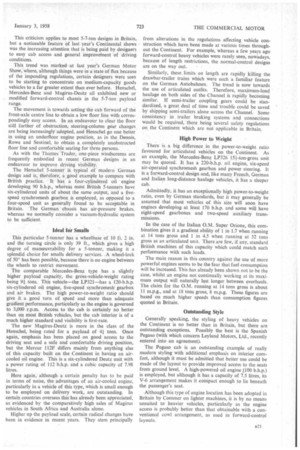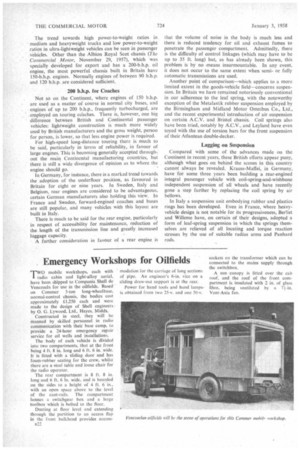This criticism applies to most 5-7-ton designs in Britain, but
Page 55

Page 56

If you've noticed an error in this article please click here to report it so we can fix it.
a noticeable feature of last year's Continental shows was the increasing attention that is being paid by designers to easy cab access and general improvetnent of driving conditions.
This trend was marked at last year's German Motor Show; where, although things were in a state of flux because of the impending regulations, certain designers were seen to be starting to concentrate on medium-capacity goods vehicles to a far greater extent than ever before. Henschel, Mercedes-Benz and Magirus-Deutz all exhibited new or modified forward-control chassis in the 5-7-ton payload range.
The movement is towards setting the cab forward of the front-axle centre line to obtain a low floor line with correspondingly easy access. In an endeavour to clear the floor still further of obstruction, steering-column gear changes. are being increasingly adopted, and Henschel go one better in using an underfloor engine position, as in the Dennis, Rowe and Sentinel, to obtain a completely unobstructed floor line and comfortable seating for three persons.
As with the Thames Trader, one-piece windscreens are frequently embodied in recent German designs in an endeavour to improve driving visibility.
The Henschel 5-tonner is typical of modern German design and is, therefore, a good example to compare with British practice. It has a four-cylindered oil engine developing 90 b.h.p, whereas most British 5-tonners have six-cylindered units of about the same output, and a fivespeed synchromesh gearbox is employed, as opposed to a four-speed unit as generally found to be acceptable in Britain. The German chassis has air-pressure brakes, whereas we normally consider a vacuum-hydraulic system to be sufficient.
Ideal for Smalls This particular 5-tonner has a wheelbase of 10 ft. 2 in. and the turning circle is only 39 ft., Which gives a high degree of manceuvrability for a 5-tonner, making it a splendid choice for smalls delivery services. .A wheel-lock of 500 has been possible, because there is no engine between the wheels to restrict movement.
The comparable Mercedes-Benz type has a slightly higher payload capacity, the gross-vehicle-weight rating being 9-1 tons. This vehicle—the LP32I—has a 120-b.h.p. six-cylindered oil engine, five-speed synchromesh gearbox and air brakes. The high power-to-weight ratio should give it a good turn of speed and more than adequate gradient performance, particularly as the engine is governed to 3,000 r.p.m. Access to the cab is certainly no better than on most British vehicles, but the cab interior is of a much higher standard and visibility is first-rate.
The new Magirus-Deutz is more in the class of the Henschel, being rated for a payload of 41 tons. Once again, emphasis has been placed on good access to the driving seat and a safe and comfortable driving position, but the Mercur 112F differs mainly from anything else of this capacity built on the Continent in having an aircooled oil engine. This is a six-cylindered Deutz unit with a power rating of 112 b.h.p. and a cubic capacity of 7.93 litres.
Here again, although a certain penalty has to be paid in terms of noise, the advantages of an air-cooled engine, particularity in a vehicle of this type, which is small enough to be employed on delivery work, are outstanding. In certain countries overseas this has already been appreciated, as evidenced by the comparatively high sales of Magirus vehicles in South Africa and Australia alone.
Higher up the payload scale, certain radical changes have been in evidence in recent years. They stem principally from alterations in the regulations affecting vehicle construction Which have been made at various times throughout the Continent. For example, whereas a few years ago forward-control heavy vehicles were rarely seen, nowadays, because of length restrictions, the normal-control designs are on the way out.
Similarly, these limits on length are rapidly killing the drawbar-trailer trains which were such a familiar feature on the German Autobahnen. The trend is now towards the use of articulated outfits. Therefore, maximum-load haulage on both sides of the Channel is rapidly becoming similar. If semi-trailer coupling gears could be standardized, a great deal of time and trouble could be saved by shipping semi-trailers alone across the Channel. Some consistency in trailer braking systems and connections would be required, there being several safety regulations on the Continent which are not applicable in Britain.
High Power to Weight
There is a big difference in the power-to-weight ratio favoured for articulated vehicles on the Continent. As an example, the Mercedes-Benz LP326 151-ton-gross unit may be quoted. It has a 220-b.h.p. oil engine, six-speed air-operated synchromesh gearbox and power steering. It is a forward-control design and, like many French, German and Italian long-distance haulage vehicles, it has a sleeper cab.
Admittedly, it has an exceptionally high power-to-weight ratio, even by German standards, but it may generally be assumed that most vehicles of this size will soon have engines developing at least 170 b.h.p. and some will have eight-speed gearboxes and two-speed auxiliary transmissions.
• In the case of the Italian O.M. Super Orione, this combination gives it a gradient ability of 1 in 1.7 when running at 14 tons gross and 1 in 4.5 when running at 32 tons gross as an articulated unit. There are few, if any, standard British machines of this capacity which could match such performance with such loads.
The main reason in this country against the use of more powerful engines seems to be the fear that fuel consumption will be increased. This has already been shown not to be the case, whilst an engine not continually working at its maximum output will naturally last longer between overhauls. The claim for the 0.M. running at 14 tons gross is about 11 m.p.g., and at 18 tons gross, 8 m.p.g. These figures are based on much higher speeds than consumption figures quoted in Britain.
Outstanding Style
Generally speaking, the styling of heavy vehicles on the Continent is no better than in Britain, but there are outstanding exceptions. Possibly the best is the Spanish Pegaso (with which concern Leyland Motors, Ltd., recently entered into an agreement).
The Pegaso cab is an outstanding example of really modern styling with additional emphasis on interior comfort, although it must be admitted that better use could be made of the layout to provide improved access to the seats from ground level. A high-powered oil engine (100 b.h.p.) is employed, but although it has a capacity of 7.5 litres, its V-6 arrangement makes it compact enough to lie beneath the passenger's seat.
Although this type of engine location has been adopted in Britain by Commer on lighter machines, it is by no means unsuited to heavier vehicles, particularly as the engine access is probably better than that obtainable with a conventional cowl arrangement, as used in forward-control layouts. The trend towards high power-to-weight ratios in medium and heavyweight trucks and low power-to-weight ratios in ultra-lightweight vehicles can be seen in passenger vehicles. Other than the Albion Royal Scot chassis (The Commercial Motor, November 29, 1957), which was specially developed for export and has a 200-b.h.p. oil engine, the most powerful chassis built in Britain have I50-b.h.p. engines. Normally engines of between 90 blip. and 120 b.h.p. are considered sufficient.
200 b.h.p. for Coaches Not so on the Continent, where engines of 150 b.h.p. are used as a matter of course in normal city buses, and engines of up to 200 b.h.p., frequently turbocharged, are employed on touring cdaches. There is, however, one big difference between British and Continental passenger vehicles: lightweight constructibn is much more widely used by British manufacturers and the gross weight, person for person, is lower, so that less engine power is required.
For high-speed long-distance touring there is much to be said, particularly in terms of reliability, in favour of large engines. This is becoming generally accepted through, out the main Continental manufacturing countries, but there is still a wide divergence of opinion as to where the engine should go.
In Germany, for instance, there is a marked trend towards the adoption of the underfloor position, as favoured in Britain for eight or nine years. In Sweden, Italy and Belgium, rear engines are considered to be advantageous, certain German manufacturers also holding this view. In France and Sweden, forward-engined coaches and buses are still popular, and many vehicles with this layout are built in Italy.
There is much to be said for the rear engine, particularly in respect of accessibility for maintenance, reduction of the length of the transmission line and greatly increased luggage capacity. A further consideration in favour of a rear engine is that the volume of noise in the body is much less and there is reduced tendency for oil and exhaust fumes to penetrate the passenger compartment. Admittedly, there is the difficulty of control linkages (which may have to be up to 35 ft. long) but, as has already been shown, this problem is by no means insurmountable. In any event, it does not occur to the same extent when semior fully automatic transmissions are used.
Another point of comparison—which applies to a more limited extent in the goods-vehicle field—concerns suspension. In Britain we have remained notoriously conventional in our adherence to the leaf spring, with the noteworthy exception of the Metalastik rubber suspension employed by the Birmingham and Midland Motor Omnibus Co., Ltd., and the recent experimental introduction of air -suspension on certain A.C.V. and Bristol chassis. Coil springs also have been tried, notably by A.C.V., and Leyland have even toyed with the use of torsion bars for the front suspension of their Atlantean double-decker.
Lagging on Suspension
Compared with some of the advances made on the Continent in recent years, these British efforts appear puny, although what goes on behind the scenes in this country cannot always be revealed. Krauss-Maffei, in Germany, have for some three years been building a rear-engined integral passenger vehicle with coil-spring-and-wishbone independent suspension of all wheels and have recently gone a step further by replacing the coil spring by air bellows.
In Italy a suspension unit embodying rubber and plastics rings hasbeen developed. Even in France, where heavyvehicle design is not notable for its progressiveness, Berliet and Willeme have, on certain of their designs, adopted a form of leaf-spring suspension in which the springs themselves are relieved of all locating and torque reaction stresses by the use of suitable radius arms and Panhard rods.




































































































